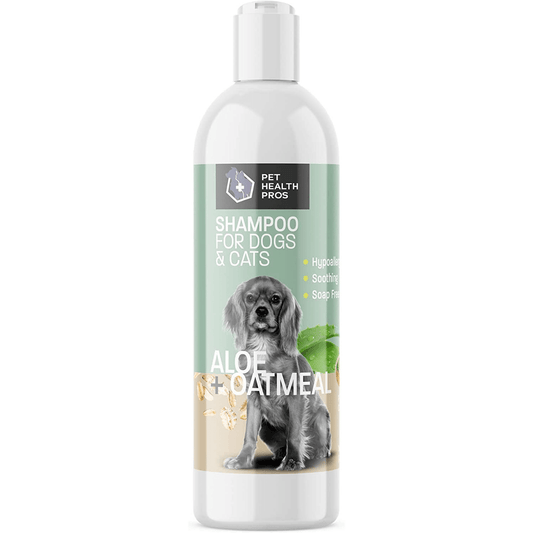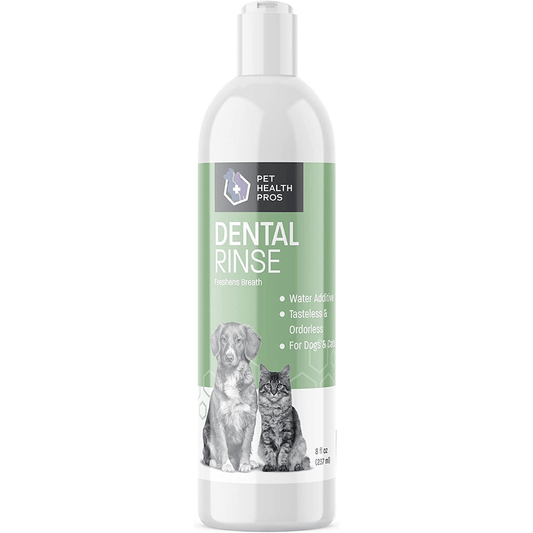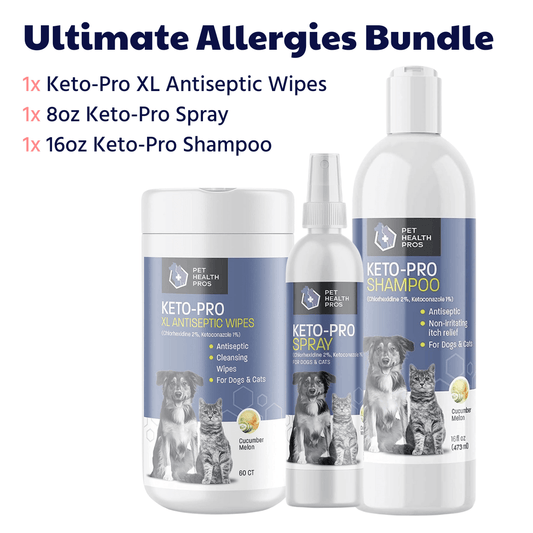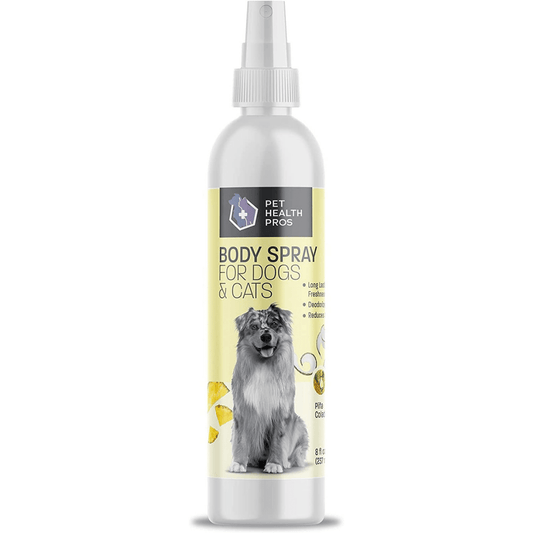Treating a dog's yeast infection in the feet can be a challenging yet essential task for pet owners. Yeast infections, particularly in the paws, can cause discomfort and more severe health issues if left untreated. This article aims to provide a comprehensive guide on identifying, treating, and preventing yeast infections in dogs' feet, ensuring your furry friend stays happy and healthy.
Key Takeaways
- Understanding the symptoms and causes of yeast infections in dogs' feet is crucial for early detection and treatment.
- Initial treatment steps include thoroughly cleaning and drying the affected area, followed by the application of medicated products.
- For persistent infections, prescription medications and innovative home remedies can offer relief.
- Preventative measures such as dietary adjustments, regular foot care, and environmental modifications can reduce the risk of future infections.
- Consulting a veterinarian is essential for severe symptoms or when unsure about the diagnosis or treatment plan.
Understanding Dog Yeast Infections in the Feet
Identifying the Symptoms
Recognizing the symptoms of a yeast infection in your dog's feet is the first step towards providing them with the relief they need. Itchy paws are one of the most noticeable signs, often causing your dog to lick or chew their feet excessively. This can lead to redness, swelling, and a noticeable odor. Other symptoms include:
- Changes in skin color or texture
- Hair loss around the affected area
- Crusty or flaky skin
It's important to note that these symptoms can also be indicative of other conditions, so accurate diagnosis is crucial.
Identifying these symptoms early can help prevent the infection from worsening. If you notice any of these signs, it's advisable to start with basic care and consult a veterinarian for a proper diagnosis and treatment plan. Remember, a yeast infection can cause significant discomfort for your dog, so timely intervention is key.
Common Causes and Risk Factors
Understanding the common causes and risk factors of dog yeast infections in the feet is crucial for prevention and effective treatment. Moisture trapped in the paws from swimming, bathing, or humid weather conditions can create an ideal environment for yeast to thrive. Dogs with allergies may also be more susceptible, as their skin can be more prone to infections.
- Allergies: Reactions to food or environmental allergens can compromise the skin barrier.
- Compromised Immune System: Dogs with weakened immune systems are at higher risk.
- Breed Predisposition: Certain breeds with dense fur or folded skin are more prone to moisture retention.
Note: Regularly checking your dog's feet for signs of redness, swelling, or unusual odor can help catch yeast infections early.
Additionally, dogs that frequently walk on contaminated surfaces or those with pre-existing skin conditions are more likely to develop infections. Ensuring your dog's paws are clean and dry, especially after outdoor activities, is a simple yet effective step towards preventing yeast infections in their feet.
Initial Steps for Treating Your Dog's Yeast Infection
Cleaning and Drying the Affected Area
Properly cleaning and drying your dog's feet is a critical first step in treating yeast infections. Begin by gently washing the affected area with a mild, pet-safe cleanser. This helps remove any debris and irritants that could exacerbate the infection. After washing, thoroughly dry the area, as moisture can promote further yeast growth.
It's essential to ensure the feet are completely dry before applying any medicated products.
Choosing the right products for cleaning and drying is crucial. Look for cleansers specifically designed for dogs with sensitive skin or infections. Avoid human products, which can be too harsh for your pet's skin. Here's a simple list to follow:
- Use a mild, pet-safe cleanser
- Rinse thoroughly to remove all soap residue
- Pat the area dry with a clean towel
- Ensure the feet are completely dry before applying any treatments
By following these steps, you can create a clean and dry environment that's less hospitable to yeast, setting the stage for effective treatment.
Choosing the Right Medicated Products
After cleaning and drying your dog's feet, selecting the right medicated products is crucial for effective treatment. Consulting with a veterinarian is essential to ensure the medication chosen is suitable for your dog's specific condition. There are a variety of medicated products available, including shampoos, creams, and sprays, each designed to target different aspects of yeast infections.
It's important to select products that are specifically formulated for dogs, as human products may contain harmful ingredients.
When browsing for medicated products, consider those that have been vet-recommended and made with high-quality, locally sourced ingredients. Products that offer a satisfaction guarantee can also provide peace of mind. Here's a quick list of factors to consider:
- Vet-recommended
- Made in the USA
- Satisfaction guarantee
- Formulated specifically for dogs
Choosing the right products is a step towards your dog's recovery and comfort.
Advanced Care Options
Prescription Medications
When it comes to treating your dog's yeast infection in the feet, prescription medications play a crucial role. Veterinarians often prescribe antifungal medications to combat the yeast directly. These medications can come in various forms, including oral tablets, topical creams, or even medicated shampoos. It's essential to follow your vet's instructions closely to ensure the best outcome for your pet.
Antifungal medications are specifically designed to target and eliminate yeast organisms, providing relief from symptoms and preventing further spread of the infection. Depending on the severity of the infection, your vet might recommend a combination of treatments.
Remember, never use over-the-counter medications without consulting your veterinarian first. The wrong product can worsen your dog's condition.
For those seeking to understand the range of prescription options, here's a simplified list:
- Oral antifungal medications
- Topical antifungal creams
- Medicated shampoos
- Injectable antifungal solutions
Each treatment option has its specific application and effectiveness, tailored to the individual needs of your dog.
Innovative Home Remedies
Exploring innovative home remedies for treating dog yeast infections in the feet can offer a gentle yet effective approach to care. Apple cider vinegar, known for its antifungal properties, can be diluted with water and applied to the affected areas to help balance the skin's pH and combat yeast growth. Another popular remedy involves soaking the dog's feet in a solution of Epsom salts and warm water, as recommended by some veterinarians. This method can soothe the dog's feet and aid in healing.
It's crucial to ensure that any home remedy is suitable for your dog's specific condition and to always consult with a veterinarian before trying new treatments.
For those interested in natural options, here's a list of commonly used ingredients and their benefits:
- Apple cider vinegar: Antifungal and pH balancing
- Epsom salts: Soothing and healing
- Coconut oil: Moisturizing and antifungal
- Tea tree oil: Antifungal (use with caution and dilute properly)
While these remedies can be helpful, they are not substitutes for professional veterinary care, especially in severe cases.
Preventing Future Infections
Dietary Adjustments for Yeast Management
Making dietary adjustments is a crucial step in managing and preventing yeast infections in dogs' feet. A diet low in sugars and carbohydrates can significantly reduce the growth of yeast, as these are the primary sources of energy for yeast cells. Incorporating foods rich in probiotics and fiber can also support a healthy gut flora, which is essential for controlling yeast overgrowth.
It's important to gradually introduce any dietary changes to avoid upsetting your dog's digestive system.
Here's a simple guideline to follow:
- Reduce the intake of grains and sugars.
- Include probiotic-rich foods or supplements.
- Add fiber-rich vegetables to support digestion.
- Ensure access to fresh, clean water at all times.
Consulting with a veterinarian is vital to tailor the diet to your dog's specific needs and health condition. Dietary adjustments, combined with proper hygiene and medical treatment, can effectively manage and prevent yeast infections in dogs' feet.
Regular Foot Care and Hygiene
Maintaining regular foot care and hygiene is crucial in preventing yeast infections in dogs. Frequent inspections of your dog's paws can help identify any early signs of infection, such as redness, swelling, or an unusual odor. It's important to keep the paws dry and clean, as moisture can create an ideal environment for yeast to thrive.
- Wash your dog's feet with a mild, pet-safe cleanser after walks, especially if they have been in muddy or wet areas.
- Dry the paws thoroughly, paying special attention to the areas between the toes.
- Trim the hair around the paws to reduce the risk of moisture retention.
- Use pet-safe moisturizers to prevent cracking and dryness, which can be entry points for infections.
Note: Regular grooming and nail trimming are also essential parts of foot care that can prevent the accumulation of dirt and debris, which may lead to infections.
Environmental Modifications
Making environmental modifications can significantly reduce the risk of recurrent yeast infections in your dog's feet. Maintain a clean, dry environment to discourage yeast growth. This includes regularly cleaning bedding, floors, and any areas where your dog spends a lot of time.
- Ensure proper ventilation in sleeping and resting areas.
- Use hypoallergenic and non-toxic cleaning products.
- Avoid letting your dog walk in damp or moldy areas.
By implementing these simple changes, you can create a healthier environment that helps prevent the proliferation of yeast.
Remember, the goal is to minimize moisture and organic debris, which are breeding grounds for yeast. Regularly inspecting and cleaning your dog's paws can also help catch and address any signs of yeast infection early.
When to Consult a Veterinarian
Recognizing Severe Symptoms
When it comes to treating a dog's yeast infection in the feet, recognizing severe symptoms early can make a significant difference in the recovery process. Severe symptoms may indicate that the infection has spread beyond the feet, necessitating immediate veterinary attention. These symptoms include but are not limited to:
- Persistent itching and scratching
- Swelling and redness that extends beyond the foot
- Foul-smelling discharge
- Lethargy or depression
- Loss of appetite
It's crucial to monitor your dog closely and note any changes in behavior or worsening of symptoms. Early intervention can prevent more serious health issues.
Selecting the right treatment plan involves understanding the severity of the infection. Mild cases may be managed with topical treatments, while more severe infections could require prescription medications. Always consult with a veterinarian to ensure the most effective and safe treatment for your dog.
Understanding the Importance of Professional Diagnosis
When dealing with a dog's yeast infection in the feet, it's crucial to understand the importance of a professional diagnosis. Veterinarians possess the expertise and equipment necessary to accurately diagnose and treat yeast infections, ensuring that your pet receives the most effective care. Self-diagnosing and treating can lead to mismanagement of the condition, potentially exacerbating the problem.
It's essential to consult a veterinarian if you notice persistent symptoms or if the condition does not improve with initial home care measures.
Veterinarians can perform a variety of tests to confirm the presence of a yeast infection, including skin scrapings, cultures, and more. This comprehensive approach helps in tailoring the treatment to your dog's specific needs, which may include prescription medications, dietary adjustments, or other specialized care.
-
Key Steps in Professional Diagnosis:
- Physical examination
- Skin scrapings
- Cultures
- Allergy testing (if necessary)
Remember, early intervention by a professional can significantly improve the outcome for your pet. Do not hesitate to seek veterinary care at the first sign of trouble, as early detection and treatment are paramount in managing yeast infections effectively.
Success Stories: Recovery and Management
Case Studies of Effective Treatment
The journey to recovery from dog yeast infections in the feet can be both challenging and rewarding. Through various case studies, we've observed a pattern of success that underscores the importance of early detection and comprehensive treatment. One notable case involved a senior dog with chronic yeast infections that had resisted numerous over-the-counter treatments. Through a combination of prescription medications, dietary adjustments, and regular foot care, the dog experienced a significant improvement in symptoms and overall quality of life.
It's essential to approach treatment with patience and persistence, as recovery times can vary based on the severity of the infection and the dog's overall health.
While each case is unique, common factors contributing to successful outcomes include adherence to treatment plans, regular veterinary check-ups, and modifications to the dog's environment to reduce exposure to yeast-promoting factors. These insights can provide hope and guidance for pet owners facing similar challenges.
Testimonials from Satisfied Pet Owners
The power of personal experience cannot be underestimated when it comes to treating dog yeast infections in the feet. Satisfied pet owners have shared their success stories, highlighting the effectiveness of various treatments and care routines. These testimonials provide not only hope but also practical advice for others facing similar challenges.
The Keto Pro Spray and antiseptic wipes were particularly praised for their immediate impact on symptoms, with owners noting significant improvements from day one.
Additionally, the K9 dog chew was mentioned as a miracle worker for joint health, demonstrating the wide range of benefits that quality pet health supplies can offer. It's clear that selecting the right products can make a significant difference in the health and happiness of our furry friends.
Pet Health Pros offers affordable, top-grade pet health supplies made in the USA, backed by a 100% satisfaction guarantee. They accept various payment methods and provide a selection of products.
Selecting Quality Pet Health Supplies
Trusted Brands and Products
When selecting pet health supplies, it's crucial to opt for trusted brands that prioritize quality and safety. Pet Health Pros stands out as a leading provider, offering a range of products from medicated treatments to wellness supplements, all crafted with care and expertise. Their commitment to quality is evident in their collaboration with veterinarians and use of locally sourced, top-grade ingredients.
Note: Always check for products that are backed by a satisfaction guarantee, ensuring peace of mind in your purchases.
Here are some of the top categories of products offered by trusted brands like Pet Health Pros:
- Medicated treatments
- Wellness supplements
- Grooming essentials
- Dental care products
- Otics (ear care)
Choosing the right products for your pet involves understanding their specific needs and consulting with a veterinarian when necessary. Quality should always be a top priority, as it directly impacts the health and well-being of your furry friend.
Navigating Online Marketplaces for Best Deals
When looking for the best deals on pet health supplies online, it's crucial to leverage the power of comparison shopping. Online marketplaces like Amazon offer a vast selection of products, allowing you to compare prices, reviews, and shipping options all in one place. Utilize filters to narrow down your search to the most relevant items and check for any available coupons or discounts.
- Use price comparison tools to ensure you're getting the best deal.
- Read customer reviews to gauge product quality and effectiveness.
- Look for sellers with high ratings to ensure reliability and customer service.
- Check the product description carefully to ensure it meets your pet's needs.
Tip: Always verify the seller's return policy and product warranty to ensure a hassle-free shopping experience.
Conclusion
In conclusion, treating a dog's yeast infection in the feet requires a comprehensive approach that includes proper diagnosis, targeted medication, and ongoing care to prevent recurrence. Utilizing high-quality, vet-approved products can significantly enhance the treatment process, ensuring your pet's comfort and health. Remember, early intervention and adherence to a treatment plan are key to successfully managing yeast infections in dogs. Always consult with a veterinarian for the best course of action tailored to your pet's specific needs.
Frequently Asked Questions
How do I know if my dog has a yeast infection in their feet?
Identifying the symptoms of a yeast infection in your dog's feet includes persistent licking or chewing of the feet, redness, swelling, an unpleasant smell, and noticeable discomfort. If you observe these signs, it's crucial to consult a veterinarian for a proper diagnosis.
What causes yeast infections in dogs' feet?
Yeast infections in dogs' feet can be caused by a variety of factors including allergies, hormonal imbalances, weakened immune system, excessive moisture, and lack of proper hygiene.
How can I clean and dry the affected area?
To clean and dry the affected area, gently wash your dog's feet with a mild, pet-safe antiseptic soap and warm water. After washing, thoroughly dry the feet, including between the toes, to prevent moisture buildup.
What medicated products are recommended for treating dog yeast infections?
For treating dog yeast infections, veterinarians often recommend medicated shampoos, sprays, or wipes that contain antifungal ingredients. It's important to choose products specifically formulated for pets and approved by veterinarians.
Are there any home remedies for dog yeast infections?
While some home remedies, such as apple cider vinegar soaks, may offer temporary relief, it's essential to consult with a veterinarian before trying any home treatments to ensure they are safe and effective for your dog.
When should I take my dog to see a veterinarian for a yeast infection?
You should consult a veterinarian if your dog's symptoms persist despite initial treatment, if the infection worsens, or if you notice severe symptoms such as excessive swelling, pain, or discharge. A professional diagnosis and treatment plan are crucial for your dog's health.









